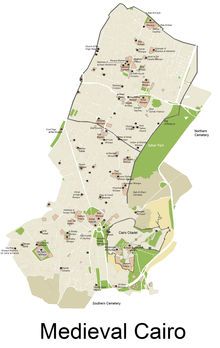Mashhad of Sayyida Ruqayya
The Mashhad of Sayyidah Ruqayyah (Arabic: مـشـهـد الـسـيـدة رقـيـة, romanized: Mashhad al-Sayyidah Ruqayyah), also referred to as the Mausoleum or Tomb of Sayyida Ruqayya[1], is a 12th-century Islamic religious shrine and mosque in Cairo, Egypt. It was erected in 1133 CE as a memorial to as-Sayyidah Ruqayyah, a member of the Prophet Muhammad's family.[2] It is also notable as one of the few and most important Fatimid-era mausoleums preserved in Cairo today.
| Mashhad of Sayyidah Ruqayyah | |
|---|---|
مـشـهـد الـسـيـدة رقـيـة | |
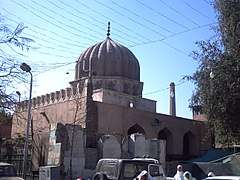 External view of the Mashhad of Sayyidah Ruqayyah. | |
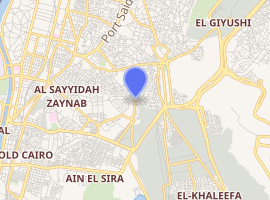
| |
| General information | |
| Status | active |
| Type | mashhad, mausoleum, mosque/oratory |
| Architectural style | Fatimid, Islamic |
| Address | 16 El-Khalifa, Al Abageyah, El-Khalifa, Cairo Governorate, Egypt |
| Coordinates | 30°01′32″N 31°15′7″E |
| Completed | 1133 |
| Renovated | 2014-2015 |
History
Sayyida Ruqayya
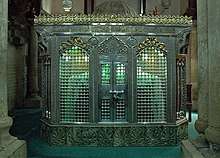
Sayyida Ruqayyah was a daughter of Ali ibn Abi Talib, her mother being one of the wives of the Caliph Ali ibn Abi Talib (who married Muhammad's daughter Fatimah). Along with Sayyida Nafisa, who is buried in a nearby mosque, she is considered to be a patron saint of Cairo.[1] Nonetheless, it is not clear that Sayyida Ruqayya ever came to Egypt or that she is actually buried here. One tradition holds that she came to Egypt with Sayyida Zaynab (also buried in an important shrine in Cairo, at the Sayyida Zaynab Mosque), just as inscriptions on the cenotaph inside this mausoleum claim that it is her tomb.[3][1] However, other traditions acknowledge Damascus as her place of burial, and see this mausoleum as a mashhad ru'ya, a "visual memorial".[3][4][5] Either way, the origin of the memorial is attributed to the Fatimid Caliph al-Hafiz, who had a dream in which he encountered a woman wearing a cloak who turned out to be Sayyida Ruqayya. He then led members of his entourage to the spot where the encounter had happened in his dream, where they dug and found an unknown tomb. Al-Hafiz then ordered that a mashhad for Sayyida Ruqayya be built on this spot.[5] The mausoleum was thus built in 1133 CE (527 AH).[3]
Historical context and environment
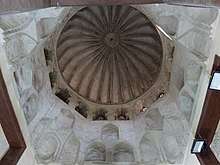
The mausoleum is located along a street leading across the al-Khalifa area (also referred to as the Sayyida Nafisa Cemetery) which is part of the wider Qarafa Necropolis of Cairo. Along the street is a concentration of important mausoleums from different periods, including those of Egypt's only female ruler since Cleopatra, Shajar ad-Durr, and of the Mamluk sultan al-Ashraf Khalil. More importantly, from a religious point of view, is the mosque and mausoleum of Sayyida Nafisa (granddaughter of Hasan, grandson of Muhammad, and buried here in 824 CE) and the mosque and mausoleum of Sayyida Sukayna (also known as Ruqayya), a daughter of Husayn (brother of Hasan). Sayyida Nafisa's life in Egypt is better-documented but Sayyida Sukayna's tomb here is apocryphal as she is widely believed to be buried in the Sayyidah Ruqayya Mosque in Damascus.[1] Right next to the mausoleum of Sayyida Ruqayya are a pair of modest domed tombs, also Fatimid in origin, which are attributed to Sayyida 'Atika (believed to be an aunt of the Prophet Muhammad) and to Muhammad al-Ja'fari (son of Ja'far al-Sadiq, the sixth Shi'i Imam).[1] With so many tombs associated to the family of the Prophet and of 'Ali, the area had notable religious importance for the Isma'ili Shi'a Fatimid dynasty, who built many of the original mausoleums here in their day.[6]
In addition to its religious significance, the mashhad is important from an architectural history perspective as it is one of the few well-preserved Fatimid buildings of its kind and represents some important developments in the architectural evolution of Cairo.[1] Among other things, the Fatimid period was the first to introduce monumental mausoleums with domes in the Islamic architecture of Egypt, seeing as early Islam originally disfavoured monumental tombs.[5] The Fatimids also introduced (or revived) traditions of visiting and spending time at the tombs of important religious saints as well as of one's own family and ancestors; a tradition that existed also in Ancient Egypt.[5]
Modern use and restoration
The mashhad is still in use as a mosque or oratory today, where religious instruction takes places and people come to pray for the saint's intercession.[1] The mashhad and some of the other nearby tombs have recently been restored by the heritage organisation Athar Lina. This involved repairing damage to the ancient structures and cleaning accumulated dirt and grime over the walls and stucco mihrabs.[7] The silver zarih (shrine enclosure) inside the mausoleum is also a relatively recent gift from the Dawoodi Bohra.[1]
Architecture
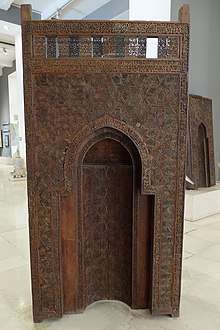
The mashhad is an important example of Fatimid architecture, and bears resemblances to the Mashhad of al-Juyushi in its layout.[2] Its entrance is preceded by triple-arched portico, as well as by two mihrabs (niches symbolizing the direction of prayer) on either side.[6] Inside the mausoleum, the space is dominated by the shrine and cenotaph, but of great architectural significance are three more mihrabs. The central mihrab is an exceptionally fine work of stucco decoration. It is often considered a masterpiece of stucco carving in Egypt's architectural history.[3][1][4] The overall design of the mihrab is reminiscent of the main portal of the Fatimid-era Aqmar Mosque, but elaborates it further and arguably represents a culmination of this design.[6] Like the other two mihrabs, it consists of a "keel"-shaped niche with radiating ribs, beyond which are elaborate arabesque and calligraphic carvings. At the center of the niche is a medallion that contains the name "'Ali" surrounded by five iterations of the name "Muhammad" linked together.[1]
The silver zarih (shrine or tomb enclosure) surrounding the cenotaph is a more recent donation from the Dawoodi Bohra, spiritual descendants of the Fatimids. It replaced a richly-crafted wooden zarih that stood there before and originally came from the nearby shrine of Sayyida Nafisa.[1] The mashhad also housed a freestanding wooden mihrab which is considered one of the finest examples of its kind from the Fatimid period. The mihrab is now on display at the Museum of Islamic Art in Cairo.[1][8] It may have originally been used in the courtyard of the mashhad and/or for special occasions.[4]
The dome is fluted (ribbed) and pointed, with an octagonal drum or base. On the inside, the transition from the octagonal base of the dome to the rest of the square chamber is achieved through a series of superimposed niches acting as squinches and giving the vague impression of stalactite-like forms. These foreshadowed the more elaborate muqarnas pendentives that would increasingly be used in later Islamic architecture in Cairo.[1] The drum of the dome also is pierced with ornate lobed windows with stucco grilles, a rare form for such windows that is only seen again in the windows of the much later Sinan Pasha Mosque.[4]
See also
- al-Qarafa (Cairo Necropolis)
- Fatimid architecture
- Sayyida Nafisa Mosque (located nearby)
- Al-Sayeda Zainab Mosque
- Shajar al-Durr (buried across the street)
- Sayyida Ruqayyah bint Al-Husain (Another important woman from the same family, with the same name)
References
- Williams, Caroline (2018). Islamic Monuments in Cairo: The Practical Guide (7th ed.). Cairo: The American University in Cairo Press.
- "Mashhad al-Sayyida Ruqayya". Archnet. Retrieved 2019-11-08.
- Yeomans, Richard (2006). The Art and Architecture of Islamic Cairo. Garnet Publishers. p. 65.
- Behrens-Absouseif, Doris (1989). Islamic Architecture in Cairo: An Introduction. Leiden, the Netherlands: E.J. Brill. pp. 74–75.
- El Kadi, Galila; Bonnamy, Alain (2007). Architecture for the Dead: Cairo's Medieval Necropolis. Cairo: The American University in Cairo Press.
- Behrens-Abouseif, Doris (2018). "The Fatimid Dream of a New Capital: Dynastic Patronage and Its Imprint on the Architectural Setting". In Melikian-Chirvani, Assadullah Souren (ed.). The World of the Fatimids. Toronto; Munich: Aga Khan Museum; The Institute of Ismaili Studies; Hirmer. p. 61.
- "AL-SAYYIDA RUQAYYA, JA'FARI AND 'ATIKA CONSERVATION PROJECT". Al Atharlina. Retrieved 2019-11-09.
- O'Kane, Bernard (with contributions by Mohamed Abbas and Iman R. Abdulfattah). 2012. The Illustrated Guide to the Museum of Islamic Art in Cairo. Cairo, New York: The American University in Cairo Press.
| Wikimedia Commons has media related to Sayyeda Ruqayya Mosque. |


